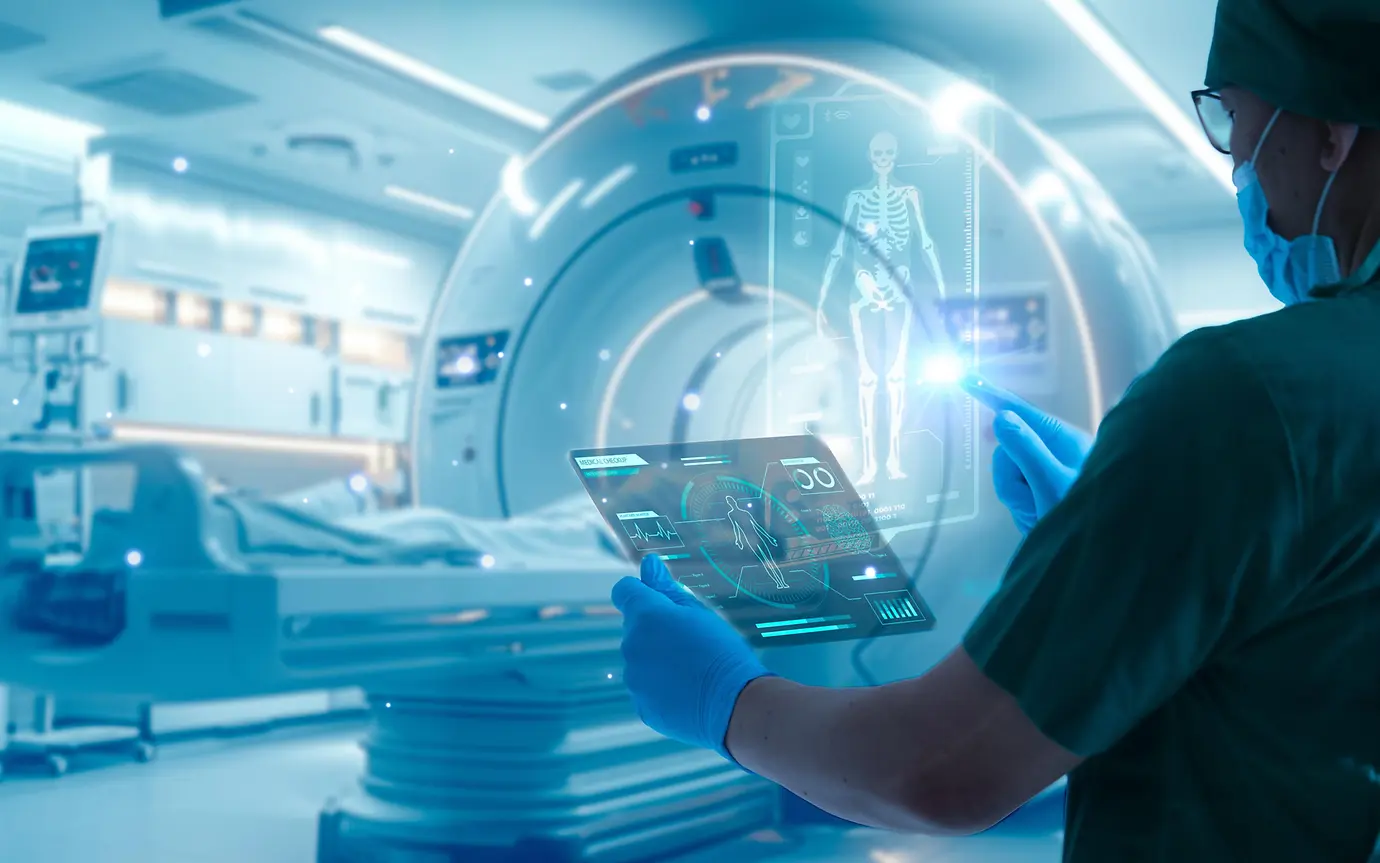
The start of 2025 has brought on the usual surge in health goals such as committing to diets or setting audacious fitness challenges. The increasingly popular commitment to give up alcohol for Dry January, and the regular uptick in gym memberships each year, demonstrate that while other macroeconomic and geopolitical trends rage on, as humans, our health and mortality are at the forefront of our minds (at least for one month of the year!). This week, we look at how artificial intelligence (AI) is driving technological advances in the health and wellness industries, and the impact these will have for generations to come.
Improvements in medical, societal, economic and environmental factors over the past 75 years have had a direct impact on our lives. In the UK, the life expectancy for men has increased from 66 for men and 72 for women in 1950, to 79 for men and 82 for women in 2024.1 We are living longer, and our living standards and quality of life have improved.
While there are obvious benefits to living longer, there are certain implications as well, namely an increased likelihood of developing various diseases or experiencing weakening bones and joints, which puts pressure on health services. To mitigate this heightened risk, many of us look to diet and lifestyle. Maybe that’s why some are giving Veganuary a try or attempting once more to complete Dry January. (Full disclosure: I am vegan and own three pairs of Birkenstocks.) Others meanwhile have re-activated their gym memberships. My personal motto? Don’t wait for the motivation to do any of these things. Just do them. Motivation comes and goes and rarely comes at the time you actually need it. However, in the words of the great Oscar Wilde: “Everything in moderation, including moderation”.

How to cope with increased longevity and the associated pressures on healthcare are just the sort of mind-bendingly complex problems that AI stands a chance of solving, or at least framing and suggesting possible courses of action.
Medicine is one area where the pace and scale of breakthroughs are so far ahead of predictions that AI won the Nobel Prize for Chemistry in 2024.2 For decades, teams of the world’s best biochemists have competed to predict how proteins look in three dimensions. A 50% success rate was considered a good result, with the caveat that the especially complex ones were essentially undeterminable. The introduction of Google DeepMind’s AlphaFold AI in 2018 was such a step up in accuracy that the next time the competition was run every single team was using AlphaFold 2. Today, while a tiny bit short of a 100% success rate, many of its predictions are within atomic levels of accuracy. This year’s Nobel Prize therefore went to the founders of DeepMind, Sir Dennis Hassabis and Dr John Jumper.3
A pharmaceutical company not using AI as part of its drug discovery and development process is already behind the curve.
In the face of continually high cancer diagnoses and ageing populations, research and development funding in this area will remain a top priority. AI will dramatically accelerate and enhance this research and therefore, it is likely that the larger ‘big pharma’ firms such as Roche, Novartis, Astra Zeneca and Johnson & Johnson, among others, will continue to lead the way in the new AI-driven reality.
In addition to research, AI is helping advance medical devices and prosthetics in leaps and bounds. Living longer means more people will need hip and knee replacements, and AI-driven 3D printing is already creating patient-specific medical devices, implants and even prosthetics.4 AI is also used to design and print customised surgical tools and implants based on a patient’s unique anatomy.5 3D printing helps reduce side effects as they perfectly mimic the joint as it once was or should have been. Much of the stigma around technology in orthopaedics has gone, and the same seems to be happening with hearing aids. Apple’s latest AirPods for example, have a degree of hearing aid functionality, which allows them to act as gateway devices for the discreet and far more technologically advanced hearing aids made by likes of Denmark’s Demant.

Governments have tried everything from traffic light labels, taxes, education, advertising restrictions and bans to get us to eat less and exercise more but obesity and the health risks associated with it continue to be a major contributor towards ill health. One potential solution is the rising popularity of a class of drugs called GLP-1s (Ozempic is the most well-known), which have been found to supress appetite, resulting in weight loss. This presents, for the first time in decades, a potentially impactful solution to obesity and its associated complications. Given only a small handful of companies are selling these drugs, it’s currently a sellers’ market.
This game changing medication may contribute towards a healthier society, given the almost endless list of co-morbidities associated with obesity, such as heart failure, type 2 diabetes, strokes, cancers and osteoarthritis. Rolling some of our January habits into the rest of the year is usually the aim, given how big an impact exercise, diet and alcohol consumption have on obesity and those co-morbidities. Time will tell if the wide-spread uptake of this drug will impact long-term public health, reducing the need for the annual January rush.
Leaving aside the moral quandary that comes from financing drugs for so-called lifestyle diseases, and putting to one side the unknown long-term side effects, GLP-1s raise the question, who pays? Should governments pay through taxation? Should insurance companies pay by raising premiums? Or should the people taking the drugs themselves pay, even though there are high correlations between obesity and poverty? As AI becomes more and more involved in drug discovery and, combined with immunotherapy, offers the real possibility of curing some cancers, sooner or later discussions will need to be had about how to pay for all this, regardless of which party is in power. Trying to get political agreement on anything in such polarised times seems a fool’s errand. However, given the amount of global and national problems stacking up, long-term thinking and cross-party agreement is vital.
But how to pay for curing diseases—what a problem to have! Science. It works. The speed at which AI discovery is moving has left many even in the industry surprised. It took almost three-quarters of a century to improve our life expectancy by 10 years. What will AI accomplish in the next 75 years?
[1] ONS
[2[ Nobel Prize: https://www.nobelprize.org/prizes/chemistry/2024/press-release/
[3] BBC: https://www.bbc.com/news/articles/czrm0p2mxvyo
[4] NCBI: https://pmc.ncbi.nlm.nih.gov/articles/PMC8970887/
[5] Forbes: https://www.forbes.com/sites/carolynschwaar/2024/03/22/ai-powered-3d-printing-redefines-implant-surgery/
This communication is provided for information purposes only. The information presented herein provides a general update on market conditions and is not intended and should not be construed as an offer, invitation, solicitation or recommendation to buy or sell any specific investment or participate in any investment (or other) strategy. The subject of the communication is not a regulated investment. Past performance is not an indication of future performance and the value of investments and the income derived from them may fluctuate and you may not receive back the amount you originally invest. Although this document has been prepared on the basis of information we believe to be reliable, LGT Wealth Management UK LLP gives no representation or warranty in relation to the accuracy or completeness of the information presented herein. The information presented herein does not provide sufficient information on which to make an informed investment decision. No liability is accepted whatsoever by LGT Wealth Management UK LLP, employees and associated companies for any direct or consequential loss arising from this document.
LGT Wealth Management UK LLP is authorised and regulated by the Financial Conduct Authority in the United Kingdom.